I’ve posted photos before of Northern Mockingbirds performing their flight displays during breeding season but I’ve found it to be virtually impossible to photograph the display from beginning to end. When I’m reasonably close to them their nearly vertical flight and subsequent return to the same perch is too fast, too high and their flight path too unpredictable for me to keep them in frame and in focus for the entire performance.
It’s possible to do when I’m far away but then my photos show little detail.
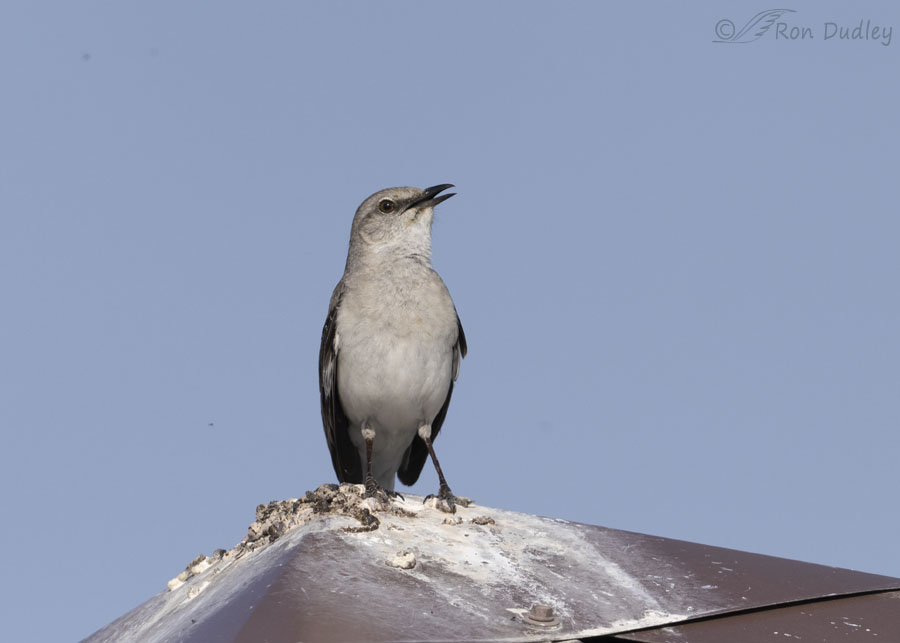
Here’s an example of my frustration, photographed two days ago on Antelope Island. The male mockingbird was perched on another poopy pavilion and displaying from there.
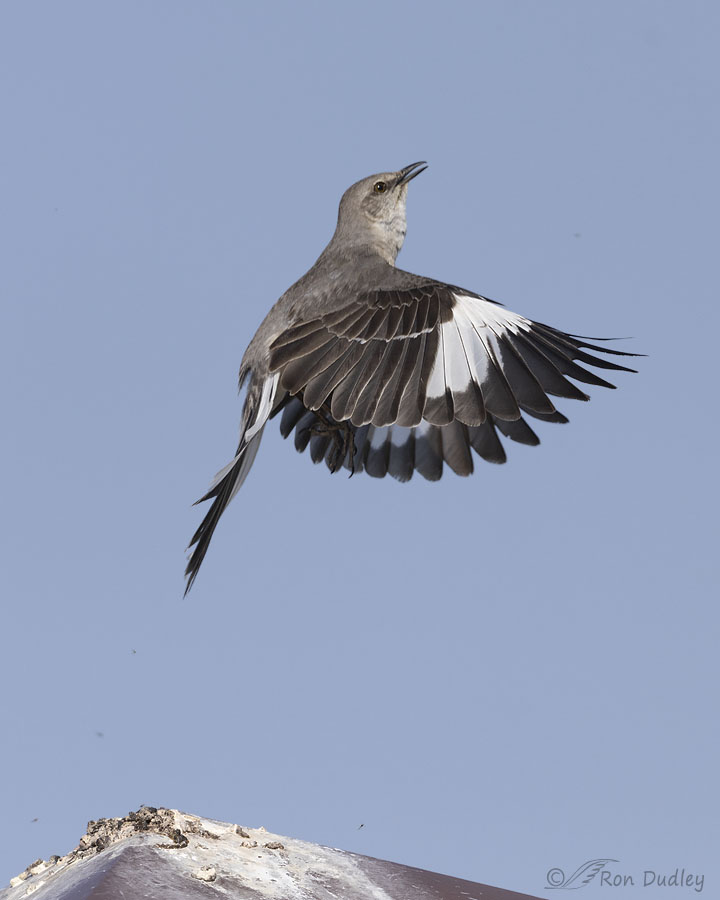
I found it to be relatively easy to get one photo of him in vertical flight immediately after takeoff but after that he was just too fast and unpredictable for me to keep him in frame and in focus. And getting them back in frame before they land on the same perch again is even harder.
As a result, I don’t think my readers (unless you’ve witnessed these performances personally) have any idea how fast the flight display is. Or how high they fly before returning to the same perch.
So two days ago on Antelope Island I tried a different tack. A couple of them, actually.
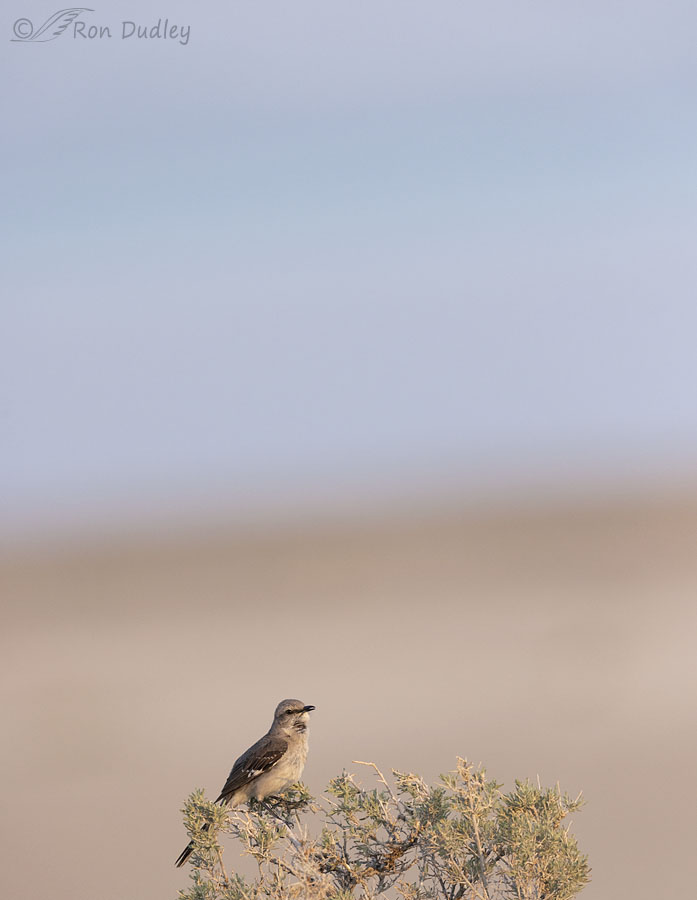
This time I was at about the right distance to keep him in frame for longer, especially if I rotated my camera 90° and shot vertically (which I did).
Shooting vertically makes it even more difficult (for me it’s impossible) to follow a moving subject so this time I didn’t try to follow him with my lens at all. I just started out with him at the bottom of the frame, initiated my burst when he took off and hoped I’d have enough room in the vertical frame to keep him ‘in the picture’ for multiple shots. I knew I couldn’t document his entire performance but this technique gave me a better chance to document more of it.
The other advantage of this technique is that it keeps the perch in the frame through multiple shots, so the viewer gets at least some idea of how high he flies and at what angle.
Following are my results from this attempt.
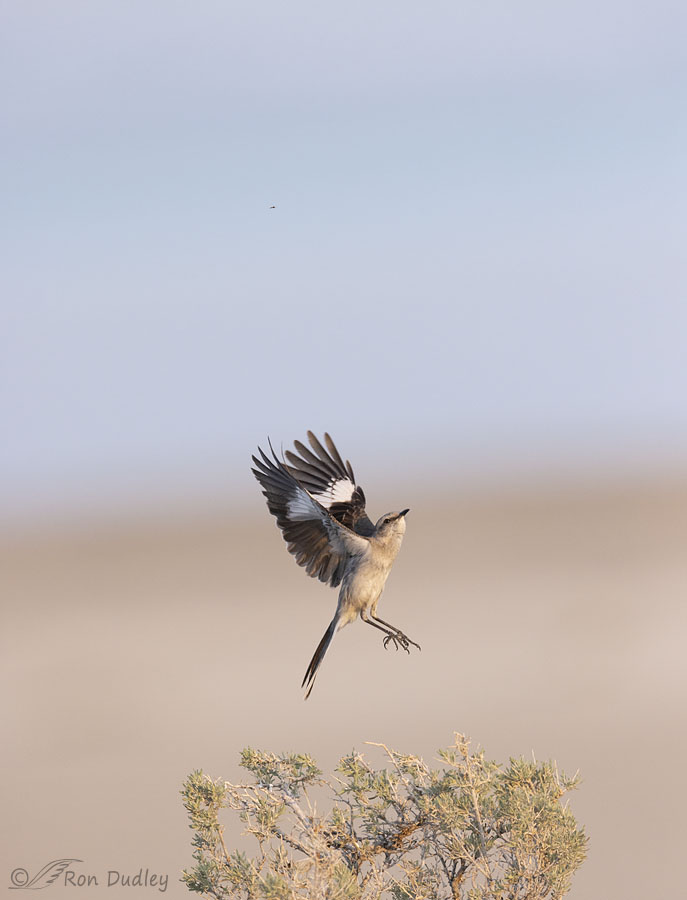
Liftoff. The blue/tan border in the background isn’t the horizon. It’s the interface between Great Salt Lake and the beach, which is why it isn’t level.
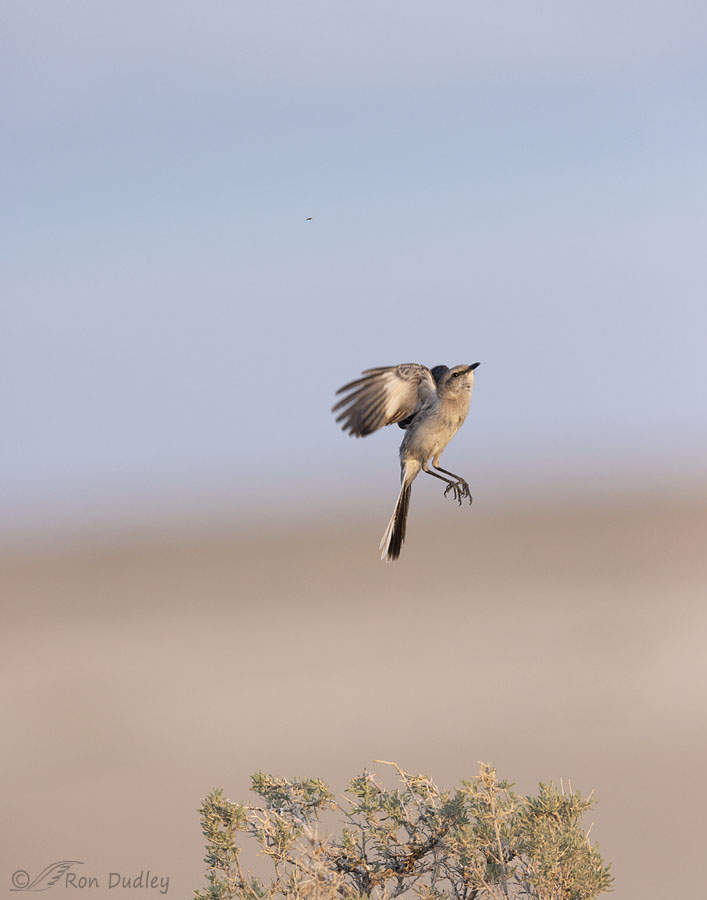
His flight path was very nearly vertical.
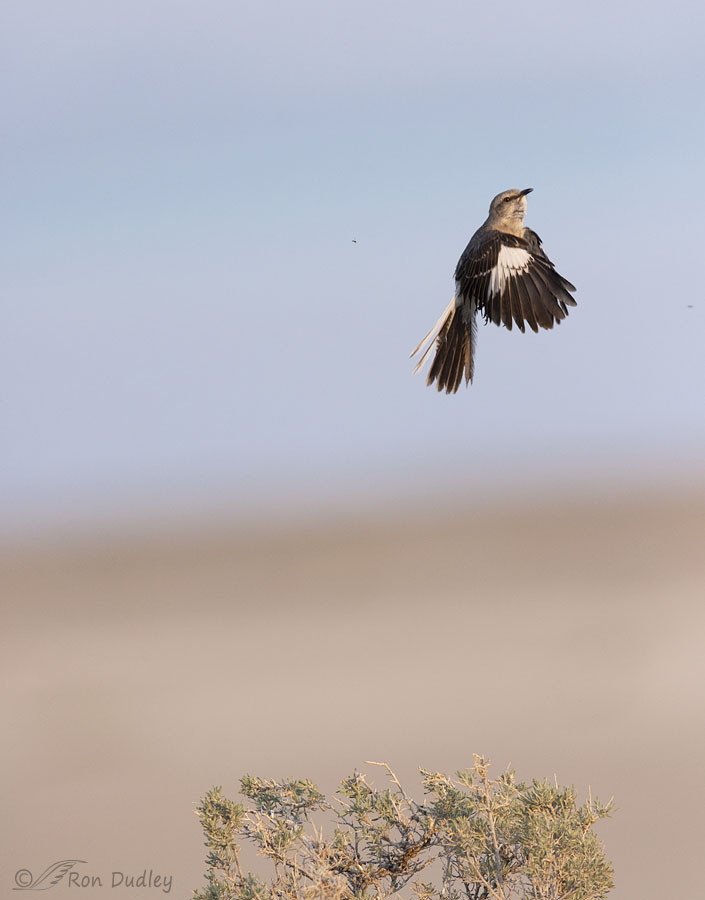
Keeping the perch in frame is the best way for the viewer to gauge his elevation and even his speed (I’m shooting at 12 frames/second).
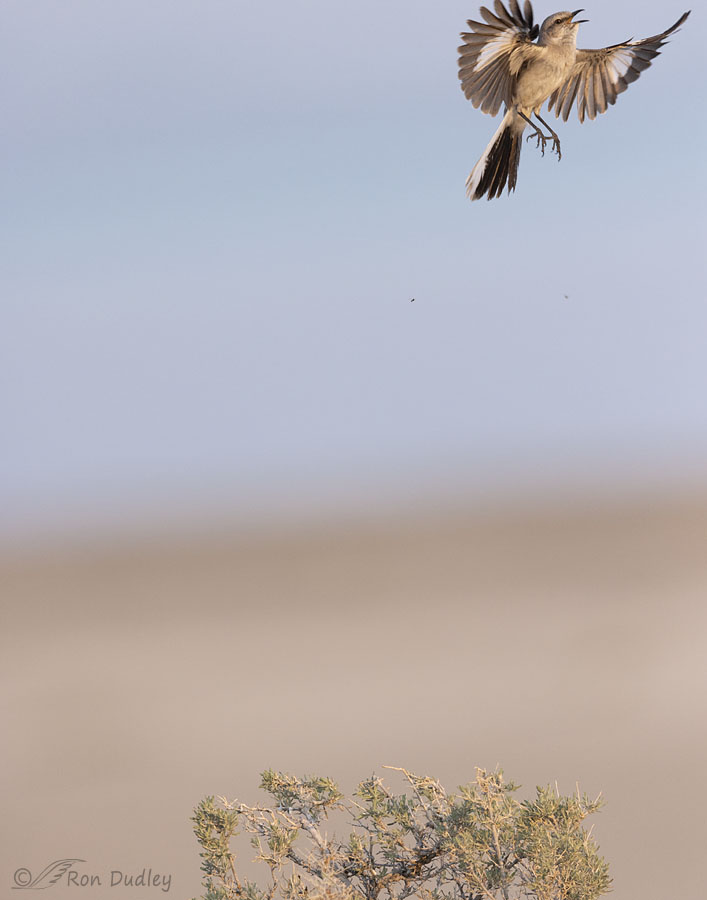
Usually they sing for the entire performance but this guy was a late starter.
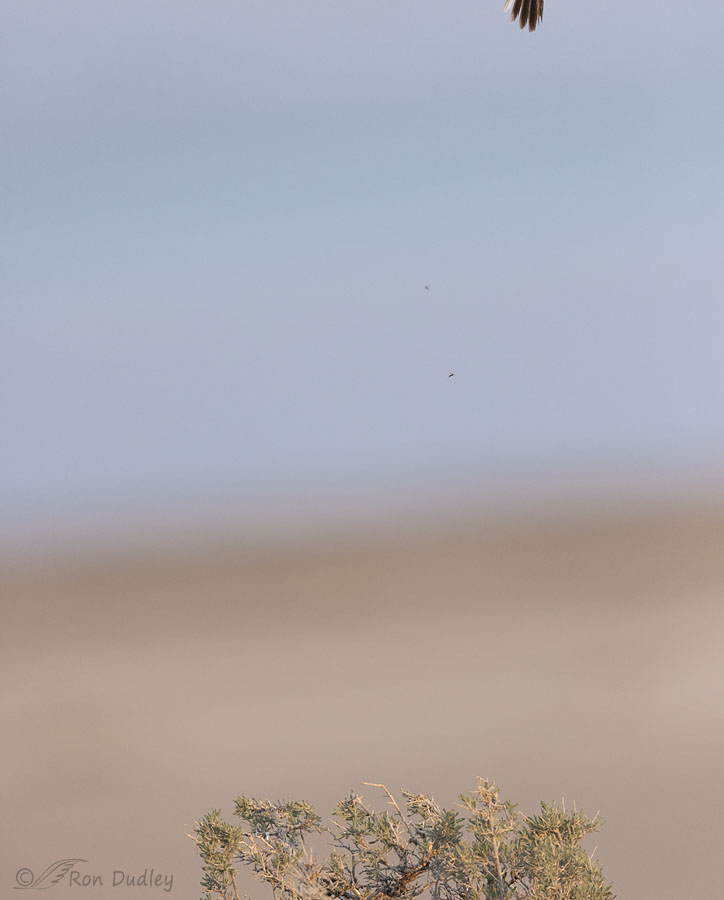
This is the last shot I got that kept any of him in frame. As you can tell, he’s still flying vertically. I’d estimate that he flew about twice as high as this before rolling over and parachuting back down to his original perch. I only kept all or part of him in frame for five shots but that’s a lot better than the one or two I’d have been able to get if I’d been using my usual technique.
But I still don’t think readers have a feeling for how long the entire performance takes. So, on the same morning, I tried a different technique using video.
I was too close to the bird to get multiple still photos of him in flight so I decided to video him taking off and leaving the frame and then keep his perch in frame until he returned to it. That video would give readers a precise feeling for the speed of his takeoff, the speed of his landing and the amount of time the entire performance took.
Without further ado, here’s the video.
That should give you an idea of how long the performance takes (it’s fast) and why it’s so difficult to get multiple still photos of the display while he’s in flight.
But knowing me, I’ll keep trying. I have a penchant for banging my head against a wall.
Ron


Thx for adding the video! My reaction after watching it the first time …. Wait, what?!!! Then watched it again several times-wicked fast!!! Wonderful comparison with your still shots! Amazing work Ron 😄
“Wait, what?!!! Then watched it again several times-wicked fast”
I did the same thing, Kathleen. Countless times.
Wicked fast, as my neighbor from back east would say! He’s out of frame in half a second — wow! Love the little poof of tail feathers in the last shot. Combined with the vertical crop and knowing you were shooting sideways, I can imagine how high he’s going. He’s taking off from a relatively soft surface too, so Newton is no help. The video is the icing on the cake. If I were a female mockingbird, I’d be damned impressed!
“He’s taking off from a relatively soft surface too, so Newton is no help.”
Marty, I love it when the science teacher in you comes out.
Thanks! And right back atcha! ❤️
Like others I accepted that he was fast – but without the video had no concept of just how fast.
Thank you – and thanks for the stills, including the amputee still.
Thanks, EC. When I amputate I don’t take just lop off a little bit…
Video narrator: “Faster than a speeding bullet!” I’d never have guessed from your stills he could possibly be moving that fast (your “12 frames per second” reference notwithstanding). Thanks for including the vid — and that final frame of the tail end! ♥️
Good to know you appreciate that “tail end” shot, Chris. I almost didn’t include it, for obvious reasons, but I’m glad I did.
Love it Ron! Like when you share your experiments.
“Like when you share your experiments.”
Experiments they were, Michael. It’s engrained in me to try different things out.
Brilliant post, Ron! Echoing others, the video is very helpful for context, the sound and speed of the display. Then one looks at the stills again and is utterly amazed at what he is accomplishing in such a short time. The blue/tan interface is lovely. And the insects in almost the same place in each photo. Were you using a tripod, or is your hand just so steady? (No photographer here, I can’t even hold my cell phone camera steady long enough for a decent shot.🤣)
You covered most of the bases, Carolyn. Thanks for taking the time to do it.
As usual, I was shooting from my pickup window, using my pool noodle as a lens rest.
Wow, the video really adds some context and makes the photos all the more special, once the speed is actually seen. It’s amazing what the new fast bursts and auto-focus make possible, but it still takes a lot of skill and technique to produce results like you have. Very interesting sequence showing the upward flight. Thanks!
You’re right, Quentin – the newer technology in cameras certainly helps.
I agree that the video aids in understanding the flight display. It also serves to allow me to appreciate how your still photography captures moments, behaviors, feathers and other details that video doesn’t. The poopy roof, however, remains the same in either.😀
Like others I am grateful that you share your experiments and document assumptions, methods and results, warts and all. The video does add to an understanding of the difficulty involved.
I’m glad you think so, Granny Pat (about the video).
That’s a good point about some of the advantages of still photos, Lyle. If I had to choose, I’d usually choose stills over video.
Watched this in Florida once. That time the bird was launching from the gable of a three story condo. It flew about 20 or 30 feet before parachuting down. You would have been able to follow and document it.
“You would have been able to follow and document it.”
Perhaps you have a wee bit too much confidence in my skills, Richard… 🙂
Wow. Without the video, I’d have no idea what was really going on here. And makes your stills all the more impressive!
“Without the video, I’d have no idea what was really going on here.”
Thanks for that, Cathy. That’s exactly why I shot and posted the video.
Very interesting and something I have never seen. I have only seen Northern Mockingbirds here once and never in flight. Watching this I would agree that it must be very difficult to follow a rapidly flying bird in a vertical flight. We are so used to birds following a horizontal flight pattern. Excellent work. Thanks for sharing this.
Thank you, Everett.
Wow. Far too fast for any appreciation of the bird’s skill and form. Both the gorgeous stills you’ve been giving us, and the video that shows the speed, are needed for me to have any understanding of what the heck I’d be seeing, were I to be there. In other words, in real life I’d actually miss it all… your work is tremendously educational.
Cheryl, I appreciated your entire comment very much.
Great series — up, up, up. Really good show-off!
Show-off indeed – the very purpose of his display.
WOW! Definitely a challenge! Video IS helpful for “geting” the speed of it all. 🙂
Thanks, Judy.
Interesting series. The video is definitely helpful for the feel of the flight and his song. I liked that you included the stills of him going completely out of frame too.
Thanks, Brett. I was nervous about you, a video expert, seeing my amateurish clip.